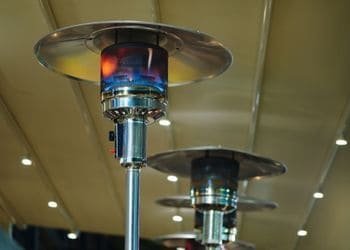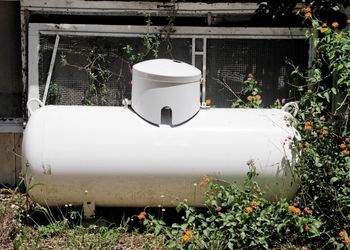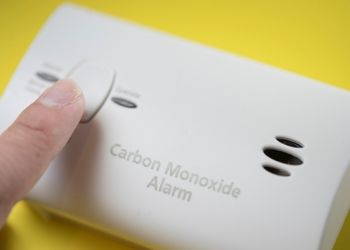You likely rely on propane heaters for heating up boilers, cookers, or even fireplaces. In the winter when the weather outside is frigid, you might feel inclined to use your propane heater indoors. Is that a safe decision?

You can use a propane heater indoors provided that it has been designed for indoor use. You should not use an outdoor propane heater in your home or office. Propane is highly flammable, which can make it a dangerous gas. It also releases carbon monoxide when burned.
In this article, we’ll discuss in far more detail whether it’s safe to use a propane heater indoors. We’ll also share some of our favorite propane heater safety tips so you can prioritize your health and wellbeing.
Table of Contents
Is It Safe to Use a Propane Heater Indoors?
Propane heaters use propane gas, which is also referred to as liquefied petroleum gas or LPG. The gas has no smell or color.
People flock to propane heaters for a multitude of reasons, including the range of temperature adjustments, the consistent heat they produce, and the lower operating costs.
However, using a propane heater indoors versus outdoors is a whole different ballgame. Is it safe?
As we touched on in the intro, you can indeed safely use a propane heater indoors if that’s what your heater is rated for.
In other words, if you’re going to be outside and you need warmth, such as during an extended camping trip, then you should only use an outdoor propane heater.
Likewise, for extra warming in your home, you must use an indoor propane heater. The way that an indoor versus an outdoor propane heater works are different enough that they should not be used interchangeably. Let’s talk further about why.
Differences Between Indoor and Outdoor Propane Heaters
Propane heaters make fumes. Besides being stinky, some of these fumes can be dangerous, such as carbon monoxide. Like propane itself, carbon monoxide has no smell or color. The gas also lacks a taste, so detecting it in the air is difficult.
An outdoor propane heater has plenty of natural ventilation via the breeze and air currents. Thus, the heater won’t include any extra forms of ventilation because it’s simply not needed.

When camping or doing any other prolonged outdoor activity with a propane heater in the vicinity, you won’t be exposed to carbon monoxide in dangerous amounts thanks to the air carrying it away.
Now imagine using that same kind of propane heater indoors. Since the propane heater has no failsafe measures against carbon monoxide, running an outdoor propane heater indoors would flood your home with carbon monoxide very quickly.
We’ll talk more about the implications of that in the next section, so be sure to check that out!
Since they’re designed for usage in enclosed spaces, indoor propane heaters must have a failsafe to control carbon monoxide levels. This is often in the form of an auto-shutoff switch.
The switch is linked to the heater’s oxygen sensor. When oxygen begins to deplete in the house, the sensor will know. The oxygen sensor then tells the auto-shutoff switch to activate. Your indoor propane heater will turn off without you having to do anything.
Many indoor propane heaters have a carbon monoxide detector as well. For best results, keep the carbon monoxide detector a few feet from the indoor propane heater. This improves the accuracy of its readings.
What Are the Risks of Propane Exposure?
Propane might be nontoxic, but that doesn’t mean it’s non-deadly. Here are three risks that can occur from propane exposure.
Asphyxiation
When propane enters the air and you breathe it in, it will begin to displace the oxygen in the air, then in your lungs.
When your lungs don’t receive enough oxygen–or worse yet, no oxygen at all–you won’t be able to breathe. This can cause you to faint, but in some cases, you could suffocate and die.
Granted, it does take a significant amount of propane in the air to deplete oxygen to the point where asphyxiation occurs, but this isn’t an impossible scenario by any means.
Flammability
Besides its ability to asphyxiate people, propane is also ultra-flammable.
The National Fire Protection Association or NFPA and the Occupational Safety and Health Administration or OSHA put together a Classification System that ranks items between 0 and 4 on flammability. Propane gas is a 4.
Yes, propane is as flammable as it gets. The reason is that the vapors in the gas will travel until they reach an ignition source.
What causes propane to ignite? If propane gas is stored in containers and then left in a heated environment such as a shed or a garage without temperature control, that’s one such source of fire.
In temperatures of 920 to 1,020 degrees Fahrenheit, propane requires no flame or spark for ignition. It would start burning on its own.

Propane usually must be in the air at a rate of 2.15 to 9.16 percent for ignition to occur. Since its flash point is -156 degrees, it can keep burning for a while.
By combining propane with chlorine or other halogens as well as oxidizing agents such as peroxides, its rate of ignition can increase.
Carbon Monoxide Poisoning
As if the two above risks of propane gas weren’t scary enough, we have to throw carbon monoxide poisoning into the mix as well, just as we said we would.
It doesn’t matter whether yours is an outdoor or indoor propane heater; it will make carbon monoxide.
The difference is that an indoor propane heater will turn itself off before carbon monoxide levels can become dangerous or even deadly. Outdoor propane heaters should use natural air to vent out the gas.
If you breathe in carbon monoxide, you could develop carbon monoxide poisoning. The symptoms include confusion, chest pain, vomiting, stomach pain, weakness, dizziness, and headache. Those symptoms are a lot like the flu but are obviously far more serious.
Continued exposure can be fatal. If you fell asleep with a propane heater on, especially an outdoor one being used indoors, you could die from carbon monoxide poisoning without experiencing the above symptoms.
Tips for Safely Using Your Propane Heater
It’s good to approach using a propane heater with a healthy dose of caution. These tips will help you and your family and friends stay safe whenever you need extra warmth from a propane heater.
Only Use Indoor Propane Heaters Indoors and Vice-Versa
As we’ve explained quite fully by this point, outdoor propane heaters are only intended for use outdoors and indoor propane heaters should be the only ones that go in the home or office.
If you’re shopping for a propane heater, read the labeling carefully to ensure it’s rated for indoor or outdoor use. No heater should be rated for both.
We can’t stress enough that this can be a deadly mistake to make. As we mentioned earlier, running an outdoor propane heater indoor will inundate your home with carbon monoxide. You learned in the last section how deadly that can be!
Don’t Buy a Bigger Propane Heater Than What You Need
The smaller the propane heater, the less carbon monoxide it produces and the safer it may be. For indoor use, there’s no need to purchase a hulking heater. More than likely, a heater of such a large size is meant for outdoor use anyway. Put it down and don’t buy it!
If Your Propane Heater Doesn’t Have a Carbon Monoxide Detector, Buy One
Many indoor propane heaters will include a carbon monoxide detector, but not all do. If yours doesn’t have one, then purchase the detector separately.

While you’re at it, it’s not a bad idea to check the carbon monoxide detectors in your house and replace their batteries if it’s been a while.
You might even decide to buy several carbon monoxide detectors and install them throughout the house close to where you use the indoor propane heater. This way, if the carbon monoxide levels in your home raise even by a little bit, you’ll know. You can then vacate the premises immediately.
Keep Your Propane Heater Away from Combustible Materials
Don’t get so preoccupied with the carbon monoxide risk that you forget how flammable propane is. Position your heater so it’s away from any flammable materials. They include curtains, carpeting, throw rugs, towels, bedding, and furniture.
Don’t Put Anything on or Near the Propane Heater
Your indoor propane heater is a heat source, not a coffee table. If you’re doing some reading on the couch with the heater by your side (at a reasonable distance, of course), don’t put your book or newspaper on the heater when you’re taking a break.
These materials are very flammable, so a fire could ignite. Even if you put a less flammable material on top of the propane heater, it will overheat and could start a fire.
Don’t Run the Propane Heater If You’re Not Going to Be in the Room
Our last tip is this: only use your indoor propane heater when needed. Thanks to their auto-off feature, indoor propane heaters are relatively safe, but propane will always carry with it some risks.
You can use a propane heater in your home, but triple-check that the heater is rated for indoor use. These propane heaters include an auto-shutoff feature that limits the amount of carbon monoxide in the air. The heater will also likely include an oxygen sensor and a carbon monoxide detector.
Outdoor propane heaters have no such accessories since the breeze carries away the carbon monoxide. Since carbon monoxide is a very deadly gas, using an outdoor propane heater indoors can have fatal consequences!